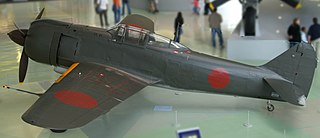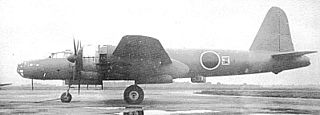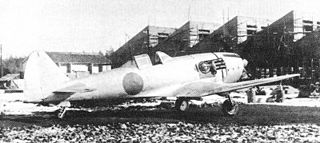Related Research Articles

The Blohm & Voss BV 155 was a German high-altitude interceptor aircraft intended to be used by the Luftwaffe against raids by USAAF Boeing B-29 Superfortresses. Work started on the design as the Messerschmitt Me 155 in 1942, but the project went through a protracted development period and change of ownership, and prototypes were still under test and development when World War II ended.
The Tupolev Tu-70 was a Soviet passenger variant of the Tu-4 bomber and designed immediately after the end of World War II. It used a number of components from Boeing B-29s that had made emergency landings in the Soviet Union after bombing Japan. It had the first pressurized fuselage in the Soviet Union and first flew on 27 November 1946. The aircraft was successfully tested, recommended for serial production, but ultimately not produced because of more pressing military orders and because Aeroflot had no requirement for such an aircraft. A military cargo aircraft version was the Tupolev Tu-75.

The Kawasaki Ki-100 (キ100) is a single-seat single-engine monoplane fighter aircraft used by the Imperial Japanese Army Air Service during World War II. The Japanese Army designation was "Type 5 Fighter". It was not assigned an Allied code name.

The Mitsubishi Ki-67Hiryū was a twin-engine heavy bomber produced by Mitsubishi Aircraft Company and used by the Imperial Japanese Army Air Service and Imperial Japanese Navy Air Service in World War II. Its Army long designation was "Army Type 4 Heavy Bomber" (四式重爆撃機). Japanese Navy variants included the P2M and Q2M.

The Nakajima G8N Renzan was a four-engine long-range bomber designed for use by the Imperial Japanese Navy. The Navy designation was "Type 18 land-based attack aircraft" (十八試陸上攻撃機); the Allied code name was "Rita".

The Nakajima Ki-84 Hayate is a single-seat fighter flown by the Imperial Japanese Army Air Service in the last two years of World War II. The Allied reporting name was "Frank"; the Japanese Army designation was Army Type 4 Fighter. The Ki-84 is generally considered the best Japanese fighter to operate in large numbers during the conflict. The aircraft boasted high speed and excellent maneuverability with an armament that gave it formidable firepower. The Ki-84's performance matched that of any single-engine Allied fighter it faced, and its operational ceiling enabled it to intercept high-flying B-29 Superfortress bombers. Pilots and crews in the field learned to take care with the plane's high-maintenance Nakajima Homare engine and a landing gear prone to buckling. The difficulties of Japan's situation late in the war took a toll on the aircraft's field performance as manufacturing defects multiplied, good quality fuel proved difficult to procure, and experienced pilots grew scarce. Nevertheless, a well-maintained Ki-84 was Japan's fastest fighter. A total of 3,514 aircraft were built.

The Kawasaki Ki-45 Toryu was a two-seat, twin-engine heavy fighter used by the Imperial Japanese Army in World War II. The army gave it the designation "Type 2 Two-Seat Fighter"; the Allied reporting name was "Nick". Originally serving as a long-range escort-fighter, the design — as with most heavy fighters of the period — fell prey to smaller, lighter, more agile single-engine fighters. As such, the Ki-45 instead served as a day and nighttime interceptor and strike-fighter.

The Kawasaki Ki-10 was the last biplane fighter used by the Imperial Japanese Army, entering service in 1935. Built by Kawasaki Kōkūki Kōgyō K.K. for the Imperial Japanese Army, it saw combat service in Manchukuo and in North China during the early stages of the Second Sino-Japanese War. Its reporting name given by the Allies was "Perry".
The Kawasaki Ki-102 was a Japanese warplane of World War II. It was a twin-engine, two-seat, long-range heavy fighter developed to replace the Ki-45 Toryu. Three versions were planned: the Ki-102a day fighter, Ki-102b ground-attack and Ki-102c night fighter. This aircraft's Allied reporting name was "Randy".

The Kawasaki Ki-32 was a Japanese light bomber aircraft of World War II. It was a single-engine, two-seat, mid-wing, cantilever monoplane with a fixed tailwheel undercarriage. An internal bomb bay accommodated a 300 kg (660 lb) offensive load, supplemented by 150 kg (330 lb) of bombs on external racks. During the war, it was known by the Allies by the name Mary.
The Tachikawa Ki-94 was a single-seat fighter-Interceptor aircraft project undertaken by the Tachikawa Aircraft Company and to be operated by the Imperial Japanese Army. The project refers to two aircraft designs: the Ki-94-I and the Ki-94-II, both of which did not advance beyond the mock-up and prototype stage respectively.

The Yokosuka B4Y,, carrier-borne torpedo bomber was used by the Imperial Japanese Navy Air Service from 1936 to 1943. The B4Y replaced the Mitsubishi B2M2 and was the last biplane bomber used operationally by the Imperial Japanese Navy. The Allied reporting name was "Jean".

The Nakajima G5N Shinzan was a four-engined long-range heavy bomber designed and built for the Imperial Japanese Navy prior to World War II. The Navy designation was "Experimental 13-Shi Attack Bomber"; the Allied code name was "Liz".

The Nakajima Ki-87 was a Japanese high-altitude fighter-interceptor of World War II. It was a single seat, exhaust-driven turbo-supercharged engined, low-wing monoplane with a conventional undercarriage.

The Mitsubishi Ki-30 was a Japanese light bomber of World War II. It was a single-engine, mid-wing, cantilever monoplane of stressed-skin construction with a fixed tailwheel undercarriage and a long transparent cockpit canopy. The type had significance in being the first Japanese aircraft to be powered by a modern two-row radial engine. During the war, it was known by the Allies by the name Ann.
The Nakajima Ki-19 was an unsuccessful attempt by Nakajima Aircraft Company to meet a 1935 requirement issued by the Japanese government for a modern bomber to replace the Mitsubishi Ki-1 heavy bomber.

The Kawasaki Ki-28, World War II Allied reporting name "Bob", was an experimental fighter aircraft designed for the Imperial Japanese Army and meant as a replacement for the Kawasaki Ki-10. It flew in 1936, but was never produced for actual use as the Army chose the Nakajima Ki-27.

The Mitsubishi Ki-33 was an experimental monoplane fighter aircraft designed for the Japanese Imperial Army. Two prototypes flew in 1936 but the design never entered production.
The Nakajima B3N was a prototype Japanese carrier-based torpedo-bomber aircraft of the 1930s. A single-engined biplane with a crew of three, it was unsuccessful, only two being built.

The Piaggio P.111 was an Italian high-altitude research aircraft designed and built by Piaggio for the Regia Aeronautica.
References
- 1 2 3 Dyer, Edwin M. III (2009). Japanese Secret Projects:Experimental aircraft of the IJA and IJN 1939–1945 (1st ed.). Hinkley: Midland publishing. pp. 14–16. ISBN 978-1-85780-317-4.